Direction Questions
In this article, we are going to have a look at the various types of questions that are framed in aptitude examinations from the chapter of directions.
Type 1: Initial Direction is given
In this type of questions, we are given:
- the initial direction of movement
- various turns taken
We need to find out the final direction of movement.
Q. A boy is going towards North-West, then he turned left 3 times and then turned right 5 times. In which direction is he going now?
(a) East (b) South-West (c) North (d) South-East
Explanation:
We are only supposed to find his final direction.
He takes 3 left turns and 5 right turns. Hence, he effectively took 5R – 3L = 2R, i.e. 2 right turns.
2 right turns means he rotated in clockwise direction by 180°.
So, he must now be moving in South-East direction.
Answer: (d)
Q. A boy is going towards North, then he turned right by 135° and then turned left 3 times. Again he turns 45° towards the right and then 225° left. In which direction is he going now?
(a) North-East (b) West (c) North (d) South-East
Explanation:
We are only supposed to find his final direction.
Total right side turns = 135° + 45° = 180°
Total left side turns = 270° (as he took 3 left turns) + 225° = 495° = (495° - 360°) = 135°
Hence, he effectively took 180° – 135° = 45° right turn, i.e. in clockwise direction.
So, he must now be moving in North-East direction.
Answer: (a)
Type 2: Final Direction is given
In this type of questions, we are given:
- the final direction of movement
- various turns taken
We need to find out the initial direction of movement.
We can solve such questions in two ways.
The first method will be to start from the final direction given, and then trace the person’s movements backwards. But this may cause you to commit some errors. So, we will use a different method, that is less error-prone.
Steps to solve such questions:
Assume that the concerned person is walking in the North direction and trace his movements.
Adjust the initial assumption based on the difference in the assumed final direction and the real final direction mentioned in the question.
Q. Bear Grylls, an adventurer, was seeking to get out of a desert. He started travelling in a particular direction and walked for 4 km. Thereafter he turned left and travelled for another 4 km. Then started walking directly towards the starting point. If his direction of movement is South-West now, then what was the direction in which he had started walking initially?
(a) South-East (b) East (c) North-East (d) North
Explanation:
Let’s assume Bear Grylls’ initial direction of movement to be North. If his starting point is A, then we can depict his path using the following diagram:
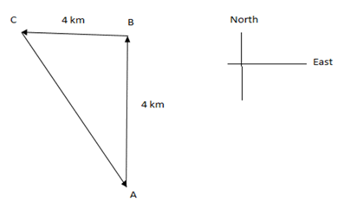
So, if the initial (assumed) direction of Bear Grylls was towards the North, then his final (assumed) direction would be South-East.
But according to the question, Bear Grylls’ real final direction of movement is South-West, i.e. 90° towards the clockwise direction with respect to the assumed final direction.
Hence, his actual initial direction must also be 90° towards the clockwise direction with respect to the assumed initial direction. So, his actual initial direction is towards the East.
His actual movement may be depicted as below:
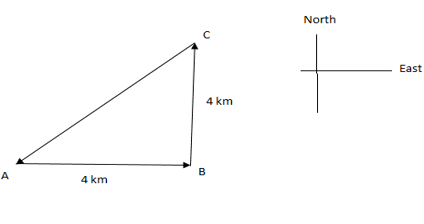
Bear Grylls moves from A to B, then from B to C and finally back to A. Hence, if the direction CA corresponds to South – West, then direction AB must correspond to East.
Answer: (b)
Type 3: Finding Relative Directions
In this type of questions, we are given:
- the initial direction of movement of an object/person, and then various turns taken by it, till it reaches the final destination or
- relative initial positions of two or more objects/persons, and then various turns taken by them.
We need to find out the relative directions of two or more objects/persons/locations (with respect to each other).
As in these questions, we are interested in finding the relative direction of an object/person/location (with respect to some other object/person/location), the distance travelled by an object/person matters.
Distances travelled do not matter in case we need to find out absolute direction.
Q. Chimu starts walking South from his house, walks for a mere 50 m, and then turns left and walks 25 m. He again turns left and walks 10 m, before turning right and walking 5 m to reach the school of his kids. What is the direction of his kids’ school from his house?
(a) North (b) North-East (c) South-West (d) South-East
Explanation:
The path taken by Chimu has been depicted in the diagram given below:
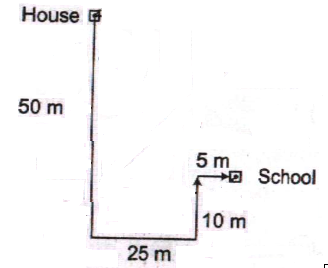
It is evident from the diagram, that kids’ school is in South-East direction from Chimu’s house.
Answer: (d)
Type 4: Clock-based Direction Questions
Sometimes direction based problems involve application of knowledge of clocks. In these type of questions, direction of minute or hour hand is to be found out as per the given time.
We first need to find the angle by which the clock is tilted and in which direction. Then we adjust the normal position of the clock hand in question accordingly.
Q. A clock, placed horizontally on a table, has been placed in such a manner that at 12 noon its minute hand points towards East. In which direction will its hour hand point at 3 pm?
(a) South (b) North (c) East (d) West
Explanation:
Generally, at 12 noon the minute hand of a clock points towards the North. So, the clock given in the question has been rotated by 90° in the clockwise direction.
At 3 pm, the hour hand will point in the South direction. It has been depicted in the diagram shown below:
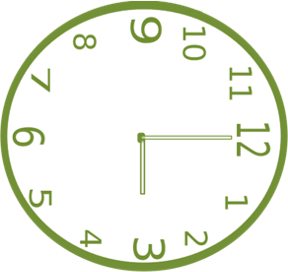
Answer: (a)
Type 5: Direction after Replacement
In this type of questions, one direction gets designated by some other direction, thereby changing the designation of other directions accordingly. We are supposed to find out the new designation of any one (or more) of the remaining directions.
We consider the shortest distance of displacement between the initial and final directions, whether clockwise or anti-clockwise.
For example, if North becomes East, then we will prefer to say that the directions have moved 90° clockwise, rather than saying that directions have moved 270° anti-clockwise.
Type 5a
Q. If South-West becomes North, then what will North-East be?
(a) North (b) East (c) South (d) South-East
Explanation:
The diagrammatic representation of directions is shown below:
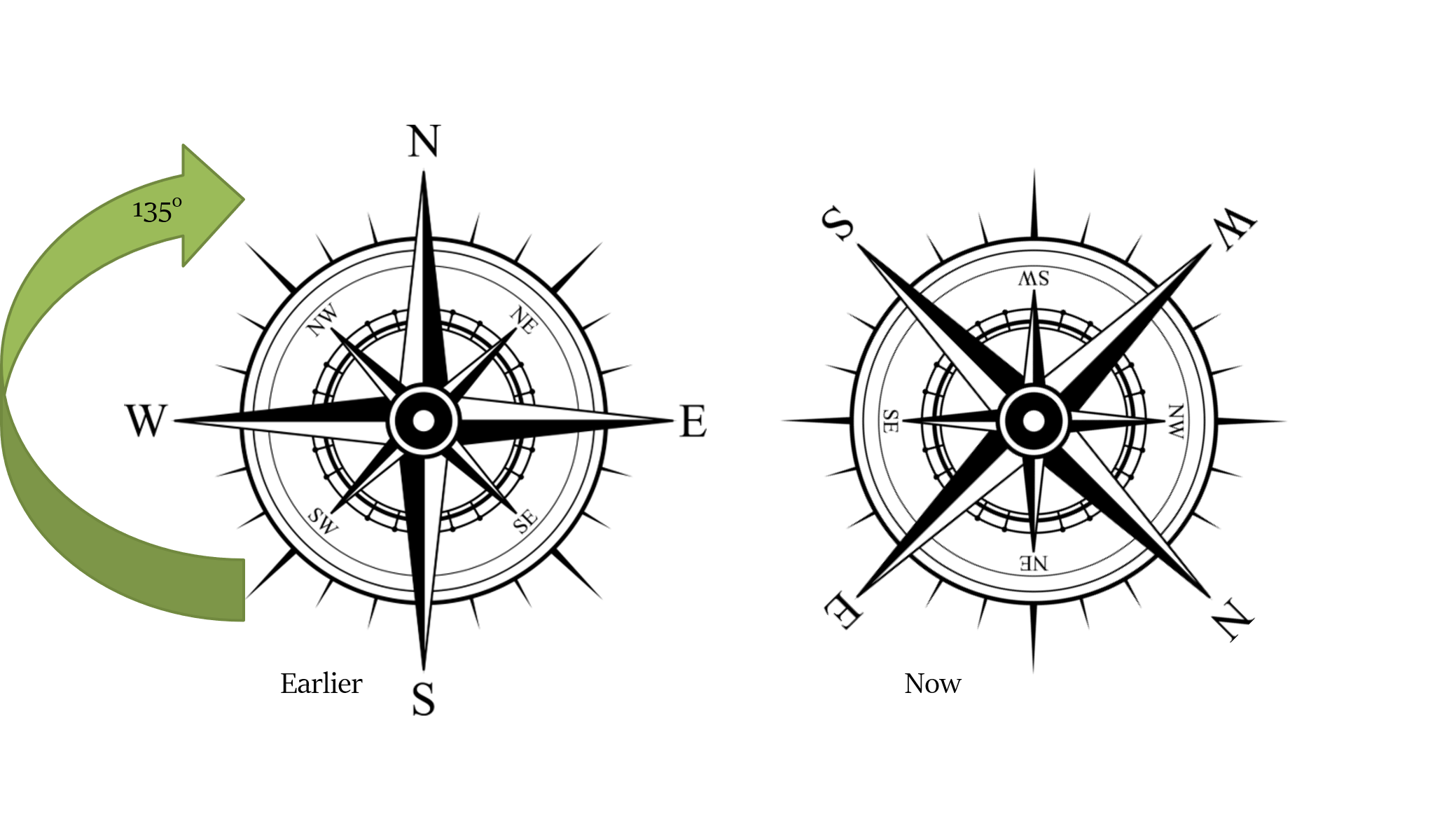
Clearly, directions have moved 135° in clockwise direction. Hence, North-East will become South.
Answer: (c)
Type 5b
Compare the following two questions, and notice the difference between the following two cases:
- When the direction board rotates.
- When the direction board is repainted.
Q. Dennis Nedry stole some Dianasore genetic material from Jurassic park and was trying to flee. However, his jeep hit a direction board on a road crossing. Due to this accident, the board turned in such a manner that the pointer which was showing East, started showing South. Dennis Nedry went towards a wrong direction, thinking it to be West. In what direction was he actually travelling ?
(a) East (b) North (c) West (d) South
Explanation:
The state of the direction board after the accident has been depicted below:

Due to an accident, the pointer showing East, started showing South. It means, that the board has been rotated by 90° in clockwise direction.
So, when Dennis Nedry thought that he was travelling towards West, he actually was moving towards the North.
Answer: (b)
Q. A direction board was situated on a road crossing. It was repainted by a novice painter in such a manner that the pointer which was showing East, was painted as South, North pointer was painted East and so on. Dennis Nedry, a traveller, went towards a wrong direction, thinking it to be West. In what direction was he actually travelling ?
(a) East (b) North (c) West (d) South
Explanation:
The state of the direction board after the repainting job has been depicted below:

Due to repaint work, the pointer showing East was painted South. It means, that the pointers have essentially been rotated through 90° in anti-clockwise direction.
So, when Dennis Nedry thought that he was travelling towards West, he actually was moving towards the South.
Answer: (d)
Type 6: Shadow-based Questions
In this type of questions, the direction of shadow is given and based on this the direction of a person or an object is to be found out.
Some concepts of shadow formation:
At the time of sunrise if a man stands facing the east, his shadow will be formed towards the west.
Similarly, at the time of sunset, when the sun sets in the west, the shadow of an object is always towards the east.
If a man stands facing the North at the time of sunrise, then his shadow will be fall towards his left and at the time of sunset it will be formed towards his right.
At 12:00, the rays of the sun fall vertically downward on a person/object and hence no shadow will be formed.
Q. The shadow casted by a pole is twice its height and points eastwards. Which of the following is the probable time of the day?
(a) 8 A.M. (b) 10 A.M. (c) 1 P.M. (d) 4 P.M.
Explanation:
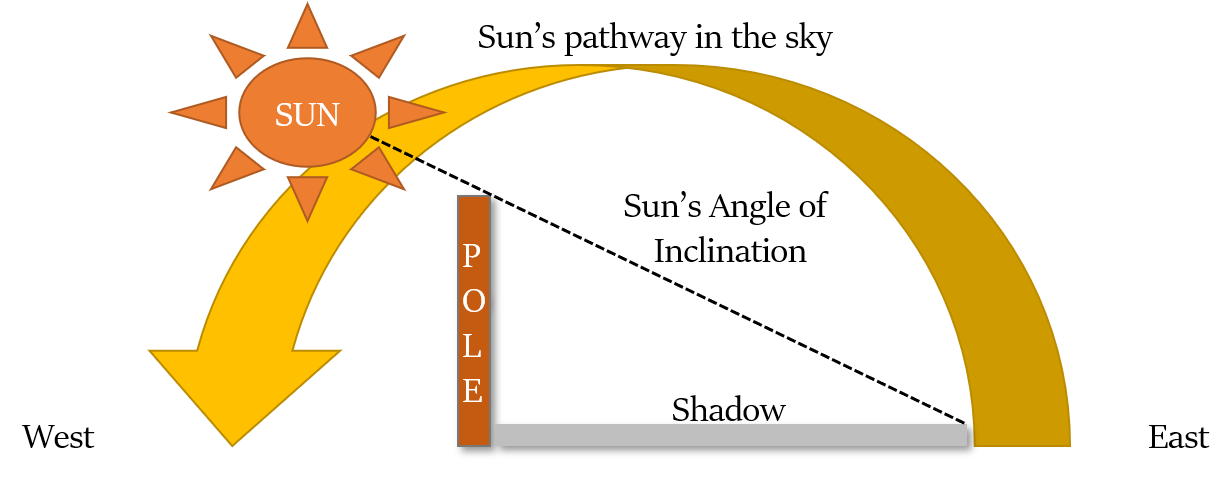
As the shadow is eastwards, therefore the sun must be in the west. Thus, it is past afternoon, i.e., options (a) and (b) are incorrect.
Now, we know that shadows are longer during morning and evening, while they are shorter near noon time.
It’s given that, length of shadow is very long as compared to the object, i.e., Sun’s angle of inclination is small as shown in diagram.
At 1 P.M., sun is still high above-head and forms a greater angle of inclination, while at 4 P.M. it will form a smaller angle of inclination.
Thus, probable time is 4 P.M.
Answer: (d)
Q. Deepak observes that whenever he moves from his home towards the library in the morning, his shadow is always formed on the right side of Amit coming from the front. While in the evening, when he leaves the library to go to the market, his shadow is always formed directly behind him. In which direction is the market from his home? (Assume that sun is the only source of light)
(a) North – East (b) North-West (c) East (d) West
Explanation:
In the morning the sun is on the East side. So, if the shadow of Deepak is formed on the right side of Amit coming from the front, it means that the shadow forms on the left side of Deepak. Hence, we can infer that he must be moving towards the North direction.
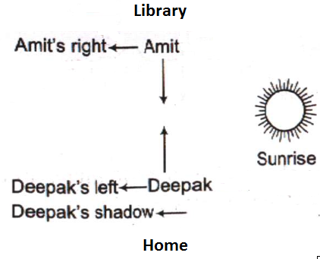
Similarly, in the evening the sun is on the West side. So, if the shadow is always formed directly behind him, it means that he is moving towards the West, i.e. the market is on the west of the library.

Hence, we can see that the market is in the North-West direction from his home.
Answer: (b)